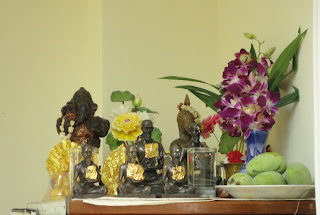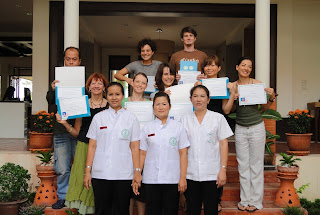For those “in the know”, the name Wat Po is synonymous with Thai Massage training in Thailand. So when I decided to travel to South East Asia, and study Thai Massage, I naturally wanted to go there. I think I initially envisaged a short course in Bangkok, dipping my toe into the Asian heritage from the safety of a 20th century city, surrounded by Western backpackers. What I got was so much more than that!
After some deliberation I decided to sign up for the “Professional Thai Massage for Health” course. This was a month long, and residential at the school in Salaya. Already this had become quite a commitment. I knew very little else about what to expect when I arrived.
The first surprise was in getting there. The taxi drivers at Bangkok bus station didn’t know it. Fortunately, the Thais are a helpful and resourceful people, and one driver who spoke some English got a phone number from the printed e-mail I was clutching, and rang up for directions. Although described as Bangkok, Salaya is actually about 40 minutes west of the city by car, and the school is 10km beyond Salaya, in the middle of rice paddies. No popping out for chips or a movie then, I was well and truly ensconced.
 |
| Diagrams showing the Sen lines in a pavilion at Wat Po Temple |
In the 20th century, Traditional Medicine declined in the Official Health System of Thailand in favour of modern medicine. (Amongst the people, however, it continued to be practised, not least because the cost of modern medical treatment made it inaccessible to a large part of the population.) In the 1950s, a group at Wat Po began to study the information preserved there, and to formalise Thai Medicine in accordance with the best practice recorded over a hundred years before. Following a request from King Rama IX, they started to teach Thai Pharmacy and Midwifery in 1955, and Thai Massage followed in 1962. Initially the students were Thais, learning in order to practise either at Wat Po or elsewhere in their own businesses. More recently, a range of courses for foreigners, taught in English, were added. These started as 1 week introductory classes; the Professional course that I chose has only been running for a year or so.
So unlike many Thai Massage Schools in Thailand, and certainly those that are recognised professionally in the UK, Wat Po is thoroughly Thai. My teachers trained at the school and worked in the Wat Po clinics, often doing massages for 10 hours a day. The links with the Wat Po temple are strong. The main clinic is in the grounds and the school headquarters where the courses for Thais are held is just around the corner. On 6th April every year there is a ceremony in the temple where teachers and students from all over the country, and the world, come together to pray to Shivaga, the Father of Thai Medicine. It’s something I’d love to experience, but unfortunately this year I had made commitments to be elsewhere in April.
 |
| Shrine to Buddha and Shivaga where we prayed each morning. |
After prayers, on most days we would have practical lessons. This started with a demonstration from the teachers, before practice on each other. Which allows me to introduce the most important people: Teacher Yimlak and Teacher Malini. These two beautiful women made us a family for our time in Salaya. They taught us, in somewhat imperfect “Thai English”, with an incredible degree of patience, warmth, humour and affection. As well as learning massage, we gained from them a great understanding of the Thai approach and thought process. Time and again Yimlak told us it was about the feeling – not doing the technique exactly right, or getting the Sen lines spot on (although she was a real stickler for this too), but giving from your heart and ensuring the client has the best possible experience from the massage.
 |
| Practising under Yimlak's watchful eye |
We had three breaks in the day, for morning “elevenses”, lunch, then tea in the afternoon. Drinks and snacks were laid on, including a range of herbal teas, some of which I now offer to my clients. Thais are very generous, so Yimlak, Malini and the other teachers would bring in treats and fruit, often from Yimlak’s garden. A favourite was green mango, which is dipped in a mixture of sugar, salt and chilli, and is wonderfully sour. I haven’t been able to find it here in the UK, more’s the pity. It also makes a great salad when grated. Yimlak lives near the school and invited us to visit, so we arrived en masse one evening. Although we had all eaten, she promptly rustled up a green mango salad and other delicious (albeit spicy) dishes for us from scratch, as well as fruit and drinks. Hospitality is taken very seriously in Thailand, and to have refused the food would have been highly insulting. Yimlak’s children and grandchildren were also around; family is very important and the generations remain very close, although people are now travelling further from home for study and work. I met several Thais who travel large distances regularly to see family and maintain links with their home.
At the end of classes for the day, we had one activity left – Rue Si Datton, or Hermit stretching. This is a series of 18 stretching movements to prepare and maintain the therapist’s body for the rigours of performing Thai massage. Again, we students couldn’t just follow the class. In pairs we had to lead a class, guiding our colleagues through the moves and giving the benefits of each. It was decidedly nerve wracking, but it could have been worse; the 18 moves we learnt are only the first section of a total of 80! If we weren’t sufficiently tired after the Rue Si Datton, our teacher, who had a mischievous streak, would up the tempo of the Thai music and lead us in Thai dancing, then Thai boxing manoeuvres! It was great fun, but in 30 degree plus heat, you definitely needed a shower afterwards!
Finally, the end of the course drew near. Which was upsetting, not just because we would have to say goodbye, but due to the approaching exam! Unlike the UK, where you get to take your own friendly “body” to exams, at Wat Po you massage “real” clients from the clinic, who are regulars and know what it is supposed to feel like. In the morning we did a one hour therapeutic treatment to address an issue the client had, then in the afternoon we gave a 2 hour relaxing massage with herbal compress to a different client. It was incredibly intimidating! Most of our clients didn’t speak English (and I don’t speak Thai) so it was very difficult to build up any rapport. Thais tend to have very solid bodies, so we were working hard, and they are stoic; despite the pummelling there was not a flicker of emotion or discomfort on their faces. (In contrast, when I receive a Wat Po massage, I usually end up wimpering – the philosophy is "no pain no gain", or "it feels bad now to feel good afterwards". Potential clients please note I do not practise in this way, unless requested!)
There were some moments of levity though – Lynn was working next to me in the afternoon, and her client fell asleep and snored throughout the 2 hours! How she gave feedback I don’t know, although the massage was undeniably relaxing.
 |
| The successful class of February 2011with our teachers |
Before I left for Thailand, I’d been told that it is better to learn Thai Massage in the West, as the standards and rigour in Thailand tend not to be up to scratch. I obviously didn’t listen, and I am so glad. It is true that the anatomy and physiology, and professionalism parts of the course aren’t as strong as you’d get in the UK, but I’ve done those here already. What you do get at Wat Po, which a Western course can’t compete with, is an immersion in the culture that gave rise to the massage. I feel I now have a contextual understanding of not just how to do a Thai Massage, but why it is that way; the view of the world into which it fits. I may not entirely agree with that view, but knowing it is the first step to integrating the great parts with my more Western outlook. It was an experience which, as a person maybe even more than a massage therapist, I wouldn’t have missed for the world.



